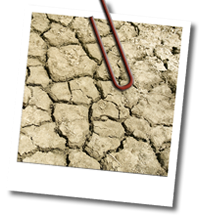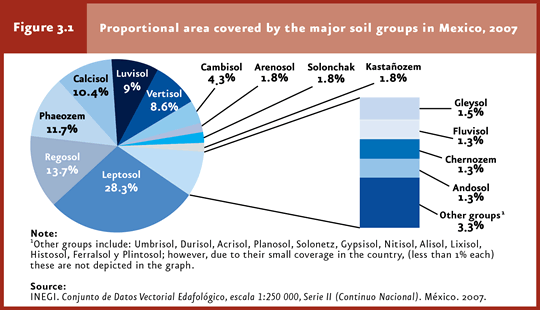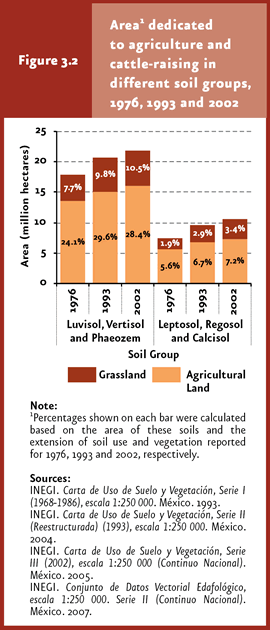
Twenty six out of the 30 soil groups acknowledged by the World Reference Base for Soil Resources (FAO-ISRIC-ISSS, 1998) are present in Mexico. |
CHAPTER 3. SOIL |
Mexico is a country characterized by a complex topography, partly derived from a heavy volcanic activity during the Cenozoic. Its altitudinal gradient ranges from zero to 5,000 meters above sea level; it includes 4 of the 5 mayor climate types acknowledged by Köppen’s classification1, and a huge diversity of landscape and rock types (including igneous, sedimentary and metamorphic rocks). Taken together, these elements contribute to explain the great diversity of soil types across the country, which is also an element of the country’s megadiversity (See boxes What is soil and how is it formed? and The environmental services of soil).
SOILS OF MEXICO According to the INEGI (2007), 26 out of the 30 soil groups acknowledged by the World Reference Base for Soil Resources (FAO-ISRIC-ISSS, 1998) are present in Mexico, the dominant types being Leptosols (28.3% of the territory), Regosols (13.7%), Phaeozems (11.7%), Calcisols (10.4%), Luvisols (9%) and Vertisols (8.6%), which jointly account for 81.7% of the country (Figure 3.1).
Fifty two point four percent of the national territory is covered by shallow and poorly developed soils: Leptosols (54.3 million hectares), Regosols (26.3 million hectares) and Calcisols (20 million hectares), thus restraining agricultural use and increasing vulnerability. Soils with the highest fertility (Phaeozems, Luvisols, and Vertisols; 22.5, 17.3 and 16.5 million hectares, respectively) jointly account for 29.4 % of the country (Figure 3.1; Map 3.1). The rest of Mexico’s territory (35 million hectares) displays a high edaphic diversity, including the other 20 groups distributed across a large number of microrelief, microclimate and vegetation types. (Cuadro D3_SUELO01_01).
Leptosols (from the greek leptos, thin), also known in other soil classification as Lithosols and Redzines, are extremely thin, rocky and poorly developed soils that may contain a large amount of limestone. These are the soils with the largest distribution worldwide (one thousand 655 million hectares; FAO-ISRIC-ITC, 2001), and are associated with areas characterized by a complex relief, a fact that explain its broad distribution in Mexico. These soil types are found across all climate types (dry, temperate, humid), and are especially common in mountainous and highly eroded areas. Its agricultural potential is limited by its small depth and high rock content, restraining agricultural practices. Furthermore, calcium contained in them may immobilize mineral nutrients, so that is preferable to preserve the original vegetation, or apply agricultural techniques suitable for these conditions. In Mexico, Leptosols are common in the Eastern Sierra Madre, Western Sierra Madre, Southern Sierra Madre, The Yucatan and Baja California Peninsulas and a huge region across the Chihuahuan desert. Particularly, in the Yucatan Peninsula leptosols include a surface layer rich in organic matter which confers a higher agricultural potential. Regosols (from the greek reghos, mantle) group soil types that cannot be classified within other groups acknowledged by the World Reference Base for Soil Resources (WRB). This soil is also denominated Entisol in other classification systems. In general, this soil type groups recently formed soils developed upon unconsolidated materials2, characterized by light colors and low organic matter content. Although Regosols occur in all climate types except for permafrost areas and at various altitudes, these are particularly common in arid, semiarid (including dry tropics) and mountainous regions. Regosols are frequently associated with Leptosols and rocky or “tepetate” outcrops. In arid zones, Regosols have a poor agricultural potential, even though their use depends on soil depth, rock abundance and fertility, reasons for which crop yield is highly variable (FAO, 2001). At a world level, Regosols comprise some 260 million hectares (FAO, 2001). In Mexico, the main areas stretch across the Western Sierra Madre, Southern Sierra Madre and the Baja California Peninsula. The commonest varieties are eutric and calcaric Regosols, characterized by a layer known as “ocric” which, upon vegetation clearance, becomes hard and crust-like, limiting plant growth. This combination (sparse plant cover plus low water infiltration into soil) leads to superficial runoff and, hence, results in erosion. Phaeozem soils (from the greek phaios, dark, and the russian zemlja, earth) are also formed upon unconsolidated materials. These soil types are found in temperate and humid climates with high grasslands or forests. Phaeozems are dark soils and with a high organic matter content, so that the agricultural potential is high, although limited to a great extent by periodic droughts plus eolic and hydric erosion. These soils are used in intensive agriculture to grow grains (soybean, wheat and barley, for example) and vegetables, and as cattle-grazing areas when covered by grasslands. At a global level, these soils comprise 190 million hectares approximately, 25% of which are located in Argentina and Uruguay grasslands (FAO, 2001). In Mexico, Phaeozem soils are distributed mostly in the Trans-Mexican Volcanic Belt, Western Sierra Madre, Yucatan peninsula and the states of Guanajuato and Queretaro. Calcisols (from the latin, calx, limestone) are known as Xerosols and Yermosols in other classifications. These soils are characteristic of arid and semiarid zones where moisture deficiency prevents leaching of soluble chemicals like salts and carbonates, especially calcium moieties, which accumulate along the soil profile and form an impermeable layer known as “caliche” or petrocalcic horizon. Calcisols support the development of xerophilous shrubland with shrubs and ephemeral grasses. Their agricultural potential may be high provided irrigation and fertilization infrastructure is available, as well as adequate drainage to prevent salinization and surface crusting derived from salt runoff and high evaporation indices (FAO, 2001). Calculating the exact world coverage of Calcisols is a complex issue, as they are frequently associated with Solonchak soils; nevertheless, the extension of Calcisols is estimated at around one thousand million hectares, mostly in arid, semiarid and subtropical areas in both hemispheres. In Mexico, this soil type occurs in the Chihuahuan desert and in the states of Aguascalientes, Baja California, Baja California Sur, Chihuahua, Coahuila, Durango, Nuevo Leon, San Luis Potosi, Sonora and Zacatecas. Luvisols (from the latin luere, wash) occur upon a number of unconsolidated materials, such as alluvial terraces or glaciar, alluvial, eolic and colluvial deposits. These are most common in temperate, cold or warm and humid climates with alternating wet and dry seasons. Luvisols are included amongst the most fertile soils, and their agricultural use is heavy and generally is dedicated to grow grains, forage and sugarcane. Luvisols stretch across some 500 to 600 million hectares worldwide (FAO, 2001). In Mexico, these are distributed in the Western Sierra Madre, the Yucatan peninsula and the states of Guerrero, Oaxaca and Campeche. Vertisols (from the latin vertere, invest) are common in semiarid to subhumid and Mediterranean climates with a marked dry/wet seasonality. The natural vegetation that grows on it includes savannas, grasslands, shrubland and timber forests. These can also be found in lacustrine beds, river banks or in periodically flooded areas. Vertisols are characterized by a high clay content, which expands with moisture and contracts with drought, forming cracks during the dry season. As a result, vertisols are hard to plough despite their high fertility, as they are very hard during the dry season and considerably sticky during the rainy season (FAO, 2001). Worldwide, Vertisols comprise around 335 million hectares, nearly half of which are dedicated to corn production (FAO, 2001). These soils are black or dark gray in central and eastern Mexico but brown-reddish to the north. Their use in agriculture is wide, varied and productive. These soils spread across a large portion of the major irrigation districts in Sinaloa, Sonora, Guanajuato, Jalisco, Tamaulipas and Veracruz. Vertisols are used for cultivating sugarcane, cereals, vegetables and cotton. These are not prone to erosion but involve a high salinization risk (INEGI, 2008). The intense agricultural development in the country over the past decades led to a high demand for the most fertile and deep soils having a good structure and a high nutrient and organic-matter content. Only between 1976 and 2002, the proportion of Luvisols, Vertisols and Phaeozems devoted to agriculture and cattle-raising rose from 31.8% (24.1% - agriculture; 7.7% - cattle-raising) to 38.9% (28.4% - agriculture; 10.5% cattle-raising, Figure 3.2). Likewise, although to a lesser extent, soils deemed less suitable for agriculture or cattle-raising are also being used for these purposes. In 1976, 7.4% of the country’s area covered by these soil types (Leptosols, Regosols and Calcisols) was dedicated to these activities and by 2002 this figure increased to 10.6% (7.2% agriculture and 3.4% cattle-raising).
Note: 1According to the modification by Garcia (1988) 2Unconsolidated material is a natural aggregate of loose, non-cemented particles.
|


